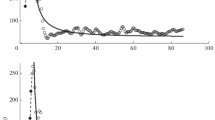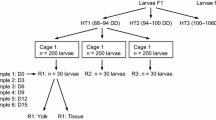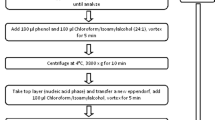Abstract
No differences in development time and mortality were detected between starved and fed laboratory raised megalopa of Pagurus bernhardus. The average time of development in 138 megalopa was determined as 7.3±0.1 (95% CI) days. During megalopa development P. bernhardus loses about 7% in dry weight (DW), 17% in carbon (C), 6% in nitrogen (N) and 17% in hydrogen (H). During development C/N ratio and individual energy content descend about 14 and 22% respectively. Weight specific energy content decreases by 17% in the first 3 d and remains constant at 12.3±0.3 (95% CI) J·(mg DW)-1 thereafter. About another 25% in individual energy content was lost by molting to crabs. The measured compounds do not follow a steady decrease. The possibility is discussed that a period of low energy cost (about the first half of development) alternates with times of higher energy expenditure mainly based on lipids. A fixed physiological program different from starvation capability is indicated for P. bernhardus megalopae. By comparing megalopae hatched in two different seasons and years reference is given to the variability in growth pattern.
Similar content being viewed by others
Literature Cited
Anger, K. and K. K. C. Nair: Laboratory experiments on the larval development of Hyas araneus (Decapoda, Majidae). Helgoländer wiss. Meeresunters. 32, 36–54 (1979)
Anger, K. and R. R. Dawirs: Influence of starvation on larval development of Hyas araneus (Decapoda, Majidae). Helgoländer wiss. Meeresunters. 34, 287–311 (1981a)
Anger, K. and R. R. Dawirs: Elemental composition (C,H,N) and energy in growing and starving larvae of Hyas araneus (Decapoda, Majidae). In preparation (1981b)
Beers, J. R.: Studies on the chemical composition of the major zooplankton groups in the Sargasso Sea off Bermuda. Limnol. Oceanogr. 11, 520–528 (1966)
Bookhout, C. G.: Salinity effects on the larval development of Pagurus bernhardus (L.) reared in the laboratory. Ophelia 1 (2), 275–294 (1964)
Bookhout, C. G.: Larval development of the hermit crab Pagurus alatus reared in the laboratory. Crustaceana 22, 215–238 (1972)
Brody, S. (Ed.): Bioenergetics and growth. 1023 pp. New York: Rheingold 1945
Childress, J. J. and M. Nygaard: Chemical composition and buoyancy of midwater crustaceans as function of depth of occurrence off southern California. Mar. Biol. 27, 225–238 (1974)
Clutter, R. I. and G. H. Theilacker: Ecological efficiency of a pelagic mysid shrimp: estimates from growth, energy budget, mortality studies. Fish. Bull. U.S. 69, 93–115 (1971)
Coffin, H. G.: The laboratory culture of Pagurus samuelis (Stimpson) (Crustacea, Decapoda). Walla Walla College Publ. 22, 1–5 (1958)
Curl, H.: Analysis of carbon in marine plankton organisms. J. mar. Res. 20, 181–188 (1962)
Dawirs, R. R.: Elemental composition (C,N,H) in larval and crab 1 stages of Pagurus bernhardus (Decapoda, Paguridae) and Carcinus maenas (Decapoda, Portunidae). Mar. Biol. 57, 17–23 (1980)
Dawirs, R. R.: Methodical aspects in rearing decapod larvae, Pagurus bernhardus (Decapoda, Paguridae) and Carcinus maenas (Decapoda, Portunidae). (In preparation)
Forss, C. A. and H. G. Coffin: The use of the brine shrimp nauplii, Artemia salina, as food for the laboratory culture of decapods. Walla Walla College Publ. 26, 1–17 (1960)
Ikeda, T.: Nutritional ecology of marine zooplankton. Mem. Fac. Fish. Hokkaido Univ. 22, 1–97 (1974)
Jackson, H. C.: Eupagurus. Mem. Liverpool Mar. Biol. Comm. 21(1-8), 1–79 (1913)
Logan, D. T. and C. E. Epifanio: A laboratory energy balance for the larvae and juveniles of the American lobster Homarus americanus. Mar. Biol. 47, 381–389 (1978)
Mayzaud, P.: Respiration and nitrogen excretion of zooplankton. II. Studies of the metabolic characteristics of starved animals. Mar. Biol. 21, 19–28 (1973)
Mayzaud, P.: Respiration and nitrogen excretion of zooplankton. IV. The influence of starvation on the metabolism and the biochemical composition of some species Mar. Biol. 37, 47–58 (1976)
Mootz, C. A. and C. E. Epifanio: An energy budget for Menippe mercenaria larvae fed Artemia nauplii. Biol. Bull. mar. biol. Lab., Woods Hole 146, 44–55 (1974)
Nyblade, C.: Larval development of Pagurus annulipes (Stimpson 1862) and Pagurus pollicaris (Say 1817) reared in the laboratory. Biol. Bull. mar. biol. Lab., Woods Hole 139, 557–573 (1970)
Omori, M.: Weight and chemical composition of some important oceanic zooplankton in the North Pacific Ocean. Mar. Biol. 3, 4–10 (1969)
Omori, M.: Growth, feeding and mortality of larval and early postlarval stages of the oceanic shrimp Sergestes similis. Limnol. Oceanogr. 24(2), 273–288 (1979)
Pandia, T. J. and K-H. Schumann: Chemical composition and caloric content of egg and zoea of the hermit crab Eupagurus bernhardus. Helgoländer wiss. Meeresunters. 16(3), 225–230 (1967)
Quetin, L. B., R. M. Ross and K. Uchio: Metabolic characteristics of midwater zooplankton: ammonia excretion, O:N ratios and the effect of starvation. Mar. Biol. 59, 201–209 (1980)
Roberts, M. H.: Larval development of Pagurus longicarpus Say reared in the laboratory, I. Descriptions of larval instars. Biol. Bull. mar. biol. Lab., Woods Hole, 139, 188–202 (1970)
Roberts, M. H.: Larval development of Pagurus longicarpus Say reared in the laboratory, II. Effects of reduced salinity on larval development. Biol. Bull. mar. biol. Lab., Woods Hole 140, 104–116 (1971)
Roberts, M. H.: Larval development of Pagurus longicarpus Say reared in the laboratory. V. Effect of diet on survival and molting. Biol. Bull. mar. biol. Lab., Woods Hole 146, 67–77 (1974)
Salonen, K., J. Sarvala, I. Hakala and M-L. Viljanen: The relation of energy and organic carbon in aquatic invertebrates. Limnol. Oceanogr. 21(5), 724–730 (1976)
Thompson, M. T.: The metamorphosis of the hermit crab. Proc. Boston Soc. nat. Hist. 31, 147–209 (1903)
Vinogradov, A. P. (Ed.): The elementary chemical composition of marine organisms. 647 pp. Yale Univ., New Haven: Sears Found. for mar. Res. 1953
Vlymen, W. J.: Energy expenditure of swimming copepods. Limnol. Oceanogr. 15, 348–356 (1970)
Author information
Authors and Affiliations
Additional information
Communicated by O. Kinne, Hamburg
Rights and permissions
About this article
Cite this article
Dawirs, R.R. Elemental composition (C, N, H) and energy in the development of Pagurus bernhardus (Decapoda: Pagurida) megalopa. Mar. Biol. 64, 117–123 (1981). https://doi.org/10.1007/BF00397100
Accepted:
Issue Date:
DOI: https://doi.org/10.1007/BF00397100




